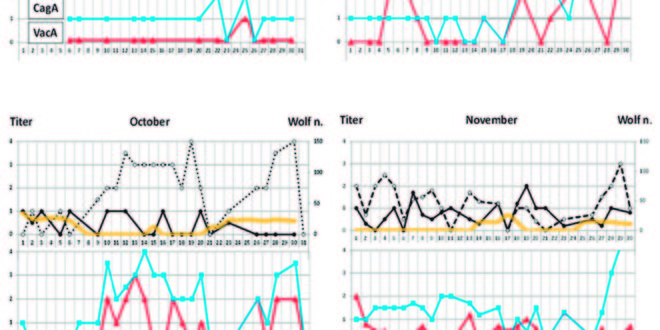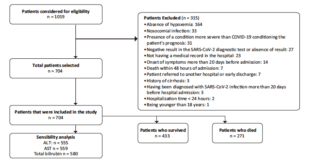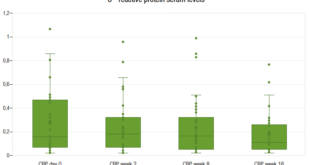Yulia A Belaya,1 Olga F Belaia,2 Svetlana M Bystrova,1 María S Vakhrameeva,1 Elena V Volchkova,2 Vladimir G Petrukhin,1 Alexander V Pronin1
1Federal State Budget Institution Gamalei, National Research Center of Epidemiology and Microbiology, Ministry of Health of the RF.
2Federal State Autonomous Educational Institution of Higher Education Sechenov First Moscow State Medical University (Sechenov University) of the Ministry of Health of the RF, Moscow, Russian Federation.
Acta Gastroenterol Latinoam 2019;49(2):119-125
Recibido: 24/04/2018 / Aprobado: 08/11/2018 / Publicado en www.actagastro.org el 17/06/2019
Summary
Objectives. To detect Helicobacter pylori (Hp) LPS/O, VacA and CagA antigens in the volunteers’ sample within the period of massive solar flare on September 2017 having its effect throughout the next months. Material and methods. Feces and saliva samples (350 tests) were taken from 11 symptom-free volunteers, median age: 34 years (range: 18-80) in the period of August to November 2017 for detecting Hp O, VacA and CagA antigens in the reaction of coagglutination (RCA) on glass slides and plates. Antigen frequency and titers were analyzed against daily solar activity, as expressed by Wolf sunspot numbers, and against solar flares occurred on September 2017. Results. A high synchronous increase in the incidence and intensity of detection of Hp LPS/O antigen in the RCA on glass and plates during the period of a powerful solar flare, and specific aftereffects were demonstrated for the consequent 1.5 months with LPS/O, VacA and CagA antigens cyclically varied in RCA on plates in both frequency and amplitude.
Key words. Helicobacter pylori, LPS, VacA, CagA, volunteers, solar activity, coagglutination.
Detección de antígenos O, VacA y CagA de Helicobacter pylori en voluntarios en el período de una llamarada potente en el Sol en septiembre de 2017 y los meses siguientes
Resumen
Objetivo. Detectar los antígenos del Helicobacter pylori (Hp) LPS/O, VacA y CagA en una muestra de voluntarios dentro del período de erupción solar masiva en septiembre de 2017 que tendrá su efecto durante los siguientes meses. Material y métodos. Desde agosto hasta noviembre de 2017 las muestras de heces y saliva (350 pruebas) de once voluntarios sin síntomas, edad mediana: 34 años, (rango: 18-80) fueron investigadas mediante la reacción de coaglutinación (RCA) en vidrio y planchetas para detectar los antígenos O, VacA y CagA de Hp en reacción de coaglutinación (RCA) en las placas de vidrio y planchetas. La frecuencia y los títulos de antígenos fueron comparados con los indicadores diarios de la actividad solar expresados como números de Wolf y con las llamaradas en el Sol en septiembre de 2017. Resultados. Se determinó un alto aumento sincrónico de la frecuencia e intensidad de detección de antígeno LPS/O de Hp en RCA en vidrio y planchetas en el período de una llamarada potente en el Sol y aumento subsecuente prolongado durante 1,5 meses de los niveles y cambios significativos de frecuencia y amplitud de las fluctuaciones cíclicas de los niveles de los antígenos LPS/O, VacA y CagA en RCA en planchetas.
Palabras claves. Helicobacter pylori, LPS, VacA, CagA, voluntarios, actividad solar, coaglutinación.
Abbreviations
CagA: cytotoxin associated protein A (a pathogenicity island marker).
SA: solar activity.
Hp: Helicobacter pylori.
LPS: lipopolysaccharide.
RCA: reaction of coagglutination.
RCAglass: reaction of coagglutination on glass slides.
RCAplate: reaction of coagglutination on plates.
SC: solar cycle.
VacA: vacuolating toxin A.
If to look back on the 20th century, there were the events that demonstrated extensive solar activity (SA) effects inducing a great number of stroke and infraction cases, accidents caused by a human factor, multiple murder-suicide cases, and conflict situations occurred in large groups of people. All the above cases may be explained by complex SA interference on a human nervous system.1-4 Solar flares are capable to cause technical failures, as well (e.g. to disable antimissile defense systems, to shut down global high-frequency wireless communication facilities, to display aurora borealis, etc.).
Our previous 16-year prospective studies of the patients with gastrointestinal disturbances and healthy volunteers tested for the frequency occurrence of the basic Helicobacter pylori (Hp) antigens – i.e. LPS/O antigen, high molecular weight proteins (HMP), VacA and CagA in biological material – had shown high sensitivity of the antigen circulation to the varied events of solar activity. Cyclic and dynamic fluctuation of the antigens occurred within various time interval (daily, monthly, seasonal, annual fluctuations) were identified at the 23rd and 24th solar cycles. It was defined that cyclic fluctuations of an LPS/O antigen (specific antigen – human Hp infection levels), as well as VacA virulence factors (vacuolating toxin A antigen) and a CagA antigen (a pathogenicity island marker), are duly correlated with SA factors expressed in Wolf numbers.5, 6
It was shown that starting with 2014; despite of the assumption that the LPS/O antigen occurrence in Hp infected persons’ feces samples is reduced, such antigen frequency remained at high level. Need to say, that very low frequencies of occurrence of VacA and CagA antigens within circulating immune complexes (CIC) were, however, noted in blood serum and saliva samples since 2015. As a matter of facts, such behavior indicates an intensive persistent pathogen vital activity (reproduction and production of toxins) and immunity disturbances followed by low specific antibody production capacity and low immune complex-bound Hp antigens. This indicated the preservation of a critical situation regarding possible exacerbations of Hp-mediated gastrointestinal diseases.7, 8
The most powerful solar flare (class X 9.3) was on September 2017, as compared to the flares to have been seen in the last 12 years, as a result of coalescence of two large-scale solar spot groups.9, 10 That flare eruption was monitored at the minimum of 24th solar cycle (SC), while such powerful flares ordinary occurs at the peak of 11-year SA. Unfortunately, the consequences of the September outbreak for life on Earth, cosmonauts and satellites in orbit cannot yet be predicted. The problem of solar flares that can affect Hp associated clinical course and chronic disease outcome had not been studied yet.
Objectives
To detect Hp LPS/O, VacA and CagA antigens in the volunteers’ feces sample during a powerful solar flare on September 2017 having its effect throughout the next months.
Material and methods
The frequency of occurrence and the intensity of detection of specific LPS/O antigen in RCAslide, as well as LPS/O antigen and VacA and CagA antigens in RCAplates along with appropriate diagnostic agents11-13 were found in feces and saliva samples (350 biological tests). A total of 11 asymptomatic volunteers, median age 34 years (range: 18-80) were repeatedly tested on August, September, October, and November, 2017. All volunteers gave informed consent and the study was approved by the local ethics committee.
For detecting Hp LPS/O antigen in RCAslides, feces samples were preliminary warmed up at 100 ºC and clarified by centrifugation (2000 rpm for 30 minutes). As for O, VacA and CagA antigens tested in RCAplates, coprofiltrates were not warmed up. A detailed sample preparation and RCA procedure is described below.14
Hp antigen levels were analyzed against daily solar activity expressed by Wolf sunspot numbers and against solar flare activity calculated by NOAA9 and P. N. Leb edev Physical Institute of the Russian Academy of Sciences (PIRAS).10
Statistical data processing was carried out using parametric (Student’s t-test) and nonparametric (X-square) analysis methods and correlation analysis in Microsoft Word for Windows, Excel 2007, BioStat 2012 software. Differences at p < 0.05 were considered statistically significant.
Results
On testing coprofiltrates on August 2017 (i.e. prior to solar flares), an O-antigen in RCAslide and LPS/O, VacA, CagA antigens in RCAplate somewhat varied.
In September, against a background of a sharp rise in CA, expressed in Wolf numbers, and the appearance of a series of outbreaks on the Sun, a simultaneous increase in the frequency of occurrence and titers of the species O-antigen was established. The major O-antigen growth was identified in RCAslide on the 2nd-4th of September and the second less growth – on the 7th of September (Figure 1). No O-antigen was identified in RCAslide over the second ten-day period of September at low and zero SA values. As for the last decade, O-antigen was detected in RCAslide at minor solar activity and decreased with its decline. On the average, frequency of O-antigen occurrence in feces sample on RCAslides was 50% over the first ten-day period of September, but such occurrence went down (20.3%; p ≤ _0.05) over the second and third ten-day period of September. In September, a reliable, direct, medium-strength correlation was found between the detection of «free» O-antigen in stool with daily solar activity expressed by Wolf sunspot numbers (r = 0.47, p = 0.03).
The significant growth of O-antigen was detected in RCAplates after the 5th of September even when no O-antigen was thereafter found in a glass slide (8-17 September) and the above level did not vary till the end of the month. It should be noted that O-antigen level in a RCAplates strongly fluctuated on September against low solar activity unlike that detected on August and was opposed in phase to the RCAslides O-antigen detection levels.
VacA antigen was not actually detected on August and over the first half of September, but it thereafter demonstrated its wavy progress over the last decade of September. CagA antigen in an RCAplates also went up within the same period synchronously with a VacA antigen.
O-antigen levels in RCAslides in feces samples were low on October against minor solar activity and the levels of all antigens in RCAplates in feces samples grew up over the second decade of October and in the end of the month so that, this tendency may be estimated as wavy-like pathogenic factors produced by a microbe throughout a long period (1.5-2 months) due to a series of SA flares at the beginning of September.
Occurrence of all antigens reduced in feces samples on November but their level was higher than on August (57% and 25% of antigen in RCAslides, p ≤ _0.05).
Frequency of O-antigen occurrence in RCAslides in saliva samples on September significantly grew up within the period of increased solar activity (96 – 100%) and thereafter a zero level was detected within the next 7 days and to go up over the last decade of the month against minor SA increase. On September, LPS/O, VacA, CagA antigen levels detected in RCAplates in saliva samples were higher than those detected in feces samples and higher than those detected in saliva samples on August. Additionally, O-antigen followed higher VacA and CagA antigen levels were detected in saliva samples a week earlier than feces levels. In September, a reliable, direct, medium-strength correlation was found between the detection of «free» O-antigen in saliva with daily solar activity expressed by Wolf sunspot numbers (r = 0.5, p = 0.02).
On October, RCAslides and RCAplates O-antigen demonstrated higher levels and frequency in saliva samples than those in feces samples; but as for VacA and CagA antigen levels, they significantly went up.
Unlike October, all antigens showed low levels in saliva samples on November against minor solar activity when no solar flares occurred and some slight fluctuations were detected.
Average monthly O-antigen titers detected in RCAplates in feces samples on September demonstrated higher levels than on August (and much higher on October), but their levels dropped on November down to the level specified on August (Figure 2).
Average monthly VacA antigen levels detected in a PCAplates showed abrupt growth on September unlike August (p ≤ _0.05), but thereafter their levels went down in 2 months.
Average monthly CagA antigen detected in an RCAplates showed the highest levels later (on October) unlike those demonstrated by VacA antigen.
Figura 1. Detection of O, VacA and CagA Hp antigens in feces of volunteers in comparison with solar activity in August- November 2017. Titer – the reaction titer in units: 1 = 1:4; 2 = 1:16; 3 = 1:64; 4 = 1:256; Wolf n. – Wolf numbers.
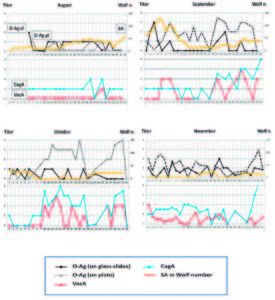
Figura 2. Average titres of O, VacA and CagA antigens in feces of volunteers in August-November 2017 in coagglutination reaction on immunological plates.
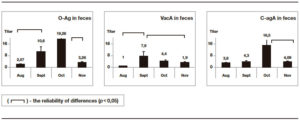
Discussion
Hp commonly cause gastro duodenal inflammatory diseases such as chronic gastritis and peptic ulcers and also is an important factor in gastric carcinogenesis.15, 16
The previously obtained data made it possible to prove high Hp sensitivity, its vital activity, production of toxins, as well as microorganism response to any solar activity variations.6-8 As it is well known high solar activity can induce a great number of stroke and infraction cases, accidents caused by a human factor, multiple murder-suicide cases, and conflict situations occurred in large groups of people.1-4 The problem of solar flares that can affect Hp associated clinical cause and chronic disease outcome, Hp antigens detection dynamic range (O, VacA, CagA antigens) for diagnosing Hp-infected patients had not been studied yet.
As a result, this paper aimed to detect Hp LPS/O, VacA and CagA antigens in the volunteers’ feces samples within the period of a massive solar flare eruption on September 2017, having its effect throughout the next months.
On carrying out studies, we came to our conclusion that frequency of the antigen occurrence within the solar activity period of September (as compared with August), significantly jumped up with Hp antigens in feces and saliva samples in the next 1.5 months (October).
As provided by the data obtained on September 2017, the previous information about high Hp sensitivity to SA and regular cyclic fluctuations of pathogenic antigens occurred synchronously with solar up and down activity, which was proved against the descending branch of the 24th solar cycle during the above extensive solar activity period followed by a massive solar flare.
Specific O-antigen levels detected in samples by RCAslides demonstrated extensive microbe vital activity to have been synchronously held over the first ten-day period of September with O-antigen levels in a glass slide sample reduced down to zero as affected by solar activity. Number, amplitude and duration of Hp antigen up-down cycles increased on September and did not vary for 1.5 months after solar fares occurred.
Dynamics of O-antigen circulation detected in samples by RCAslides is rather different from that of O-antigen circulation detected by PCAplates. Higher RCAslides O-antigen level indicates high concentration of “free” O-antigen due to microbial multiplication in its natural niche (i.e. stomach). Primarily, a great number of O-antigens detected on RCAslides were followed by low levels of O-antigen in biologic samples by RCAplates.
Taking into account the intended principles for detecting O-antigen on RCAslides and plates (warmed up and native biomaterial samples respectively), it is possible to assume that specific excess O-antigen in immune complexes can be detected in native feces and saliva samples along with free O-antigen.
And taking into account of the long-term O-antigen detection procedure in native samples performed for approximately 1.5 months, it is possible to assume that free O-antigen can be transformed to another form to have less molecular weight and to possess high polystyrene adsorption capacity. Similar structures likely have VacA and CagA antigens detected on reaction plates.
However, it cannot be ruled out that biosubstrate Hp antigens detected on polystyrene plates are presented in microvesicles.17-20 Positive dynamics of occurrence and O-antigen titers in RCAplates reflecting the behavior of free antigen which RCAslides levels come down can be detected during solar activity decay period and may be identified as transformation of an exciting agent to persistent one for adapting pathogen to unfavorable external and internal environments.
Any abrupt solar activity and massive flare occurred early September 2017, i.e. within the period of descending branch of the 24th solar cycle, may have adverse effect on Hp immunity and cause Hp aggravations and severe aftereffects (gastric ulcer, cancer). At the same time, such factors can enhance body protective functions maintaining them in active and operative conditions, which are very important in the periods of minimum solar activity between 11-year cycles.
Further monitoring procedures may be extremely important to study Hp chronic persistence performance in human body for improving aetiological diagnostics of this pathology, for evaluating treatment effectiveness and for forecasting any severe Hp aftereffects (gastric ulcer, cancer).
Authors contributions. All authors participated equally in carrying out the work and the design of the article in print.
Conflict of interest statement. The author(s) declare(s) that there is no conflict of interest regarding the publication of this paper.
Supporting. Olga F. Belaia y Elena V. Volchkova recibieron el apoyo del «Proyecto de Excelencia Académica de Rusia 5-100».
References
- Dikpati M, Cally PS, McIntosh SW, Heifetz E. The Origin of the «Seasons» in Space Weather. Sci Rep 2017; 7: 14750.
- Vencloviene J, Babarskiene R, Slapikas R, Sakalyte G. The association between phenomena on the sun, geomagnetic activity, meteorological variables, and cardiovascular characteristic of patients with myocardial infarction. Int J Biometeorol 2013; 57: 797-804.
- Komarov FI, Rapoport SI, Breus TK, OraevskiĬ _VN, El’kis NS. [Effects of solar activity on clinical pathology] [Article in Russian] Klin Med (Mosk) 1995; 73: 8-13.
- Samoylova NA, Shkilnyuk GG, Goncharova ZA,Stolyarov I.D. [The influence of solar and geomagnetic activity on the risk of multiple sclerosis (results of correlation and regression analysis)] [Article in Russian; Abstract available in Russian from the publisher] Zh Nevrol Psikhiatr Im S. S. Korsakova 2017; 117: 42-49.
- Belaya YA, Belaya OF, Petrukhin VG, Bystrova SM, Vakhrameeva MS, Cyclical fluctuations in the frequency of occurrence of Helicobacter pylori antigens in the long persistence in the body /»Results of science» Selected Works of the International symposium on fundamental and applied problems of science. Moscow: Russian Academy of Sciences 2013; V 3, Chapter 9: 146-157.
- Belaya YuA, Belaya OF, Petrukhin VG, Vakhrameeva MS, Bystrova SM, Pronin AV. Immunologic monitoring of Helicobacter pylori persistence in the organism. Zh. Mikrobiol Epidemiol Immunobiol (Moscow) 2015; 4: 106-112.
- Petrukhin VG, Belaya YA, Vakhrameeva MS, Belaia OF, Bystrova SM. Helicobacter pylori infection in patients with different age and in different years of solar activity. XII International Crimean conference «Cosmos and Biosphere», Alushta, Crimea, Russia. October 2-6, 2017: 146-149.
- Belaya YA, Belaya OF, Petrukhin VG, Bystrova SM, Vakhrameeva MS, Pronin AV. Increase of Helicobacter pylori infection and decrease in immunity in recent years. Acta Gastroenterol Latinoam 2017; 47: 126-130.
- Solar and geomagnetic data. http://www.solen.info/solar/indices.html
- Laboratory of X-ray astronomy of the Sun LPI. http://tesis.lebedev.ru/
- Belaya YA, Belaya OF, Petrukhin VG. A method for producing diagnostic kit for the detection of Helicobacter pylori antigens in coagglutination reaction. Patent RUS 2186394.
- Belaya YF, Sheklakova LA, Vakhrameeva MS, ZhukhovitskiĬ _VG, Petrukhin VG, Belaya YuA. Production of recombinant fragment of VacA protein and development of non-invasive method for the diagnosis of Helicobacter pylori infection. Mol Gen Mikrobiol Virusol. Moscow «Meditsina» 2005; 1: 32-35.
- BelayaYA, Vakhrameeva MS, Belaya YF, Belaya OF, Petrukhin VG. A method for producing a test system for the determination of protein antigens of citotoxin-associated proteins of Helicobacter pylori in biological material of infected individuals in coagglutination reaction. Patent RUS N° 2232989.
- Belaya OF, Cherkasov VL, Belaya YA, Bystrova SM, Tseneva GY, Vyalbe EV. Coagglutination reaction at infectious diseases. Guidelines. Moscow 1990: 1-12.
- Miller GG, Mukhachev AY, Bykovsk AF. Interconnection between cell micro-vesicular transport and pathogens persistence in vitro and in vivo. Zh. Mikrobiol Epidemiol Immunobiol (Moscow) 2015; 4: 63-70.
- Salama NR, Hartung ML, Müller A. Life in the human stomach: persistence strategies of the bacterial pathogen Helicobacter pylori. Nat Rev Microbiol 2013; 11: 385-399.
- Mullaney E, Brown PA, Smith SM, Botting CH, Yamaoka YY, Terres AM, Kelleher DP, Windle HJ. Proteomic and functional characterization of the outer membrane vesicles from the gastric pathogen Helicobacter pylori. Proteomics Clin Appl 2009; 3: 785-796.
- Yáñez-Mó M, Siljander PR, Andreu Z, Zavec AB, Borràs FE, Buzas EI, Buzas K, Casal E, Cappello F, Carvalho J, Colás E, Cordeiro-da Silva A, Fais S, Falcon-Perez JM, Ghobrial IM, Giebel B, Gimona M, Graner M, Gursel I, Gursel M, Heegaard NH, Hendrix A, Kierulf P, Kokubun K, Kosanovic M, Kralj-Iglic V, Krämer-Albers EM, Laitinen S, Lässer C, Lener T, Ligeti E, Linē _A, Lipps G, Llorente A, Lötvall J, Manček-Keber M, Marcilla A, Mittelbrunn M, Nazarenko I, Nolte-‘t Hoen EN, Nyman TA, O’Driscoll L, Olivan M, Oliveira C, Pállinger É, Del Portillo HA, Reventós J, Rigau M, Rohde E, Sammar M, Sánchez-Madrid F, Santarém N, Schallmoser K, Ostenfeld MS, Stoorvogel W, Stukelj R, Van der Grein SG, Vasconcelos MH, Wauben MH, De Wever O. Biological properties of extracellular vesicles and their physiological functions. J Extracell Vesicles 2015; 4: 27066.
- Chitcholtan K, Hampton MB, Keenan JI. Outer membrane vesicles enhance the carcinogenic potential of Helicobacter pylori. Carcinogenesis 2008; 29: 2400-2405.
- Ismail S, Hampton MB, Keenan JI. Helicobacter pylori outer membrane vesicles modulate proliferation and interleukin-8 production by gastric epithelial cells. Infect Immun 2003; 71: 5670- 5675.
Correspondencia: Yulia Aleksándrovna Bélaya
Gamaleya Str. 18 Moscú 123098, Rusia.
Tel.: +7 (499) 193-30-01
Correo electrónico: belaya.ya2013@yandex.ru
Acta Gastroenterol Latinoam 2019;49(2):119-125
 Revista ACTA Órgano Oficial de SAGE
Revista ACTA Órgano Oficial de SAGE
